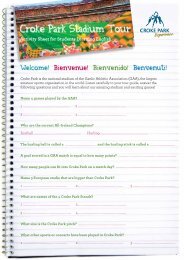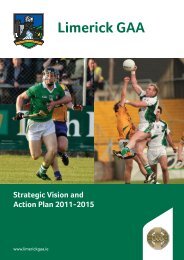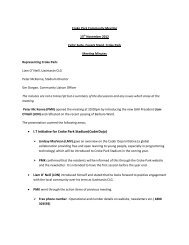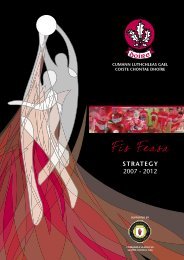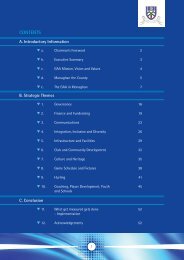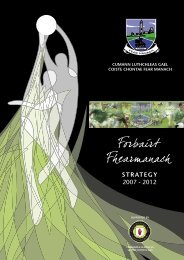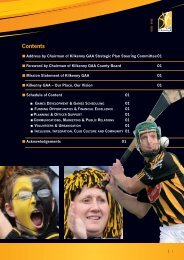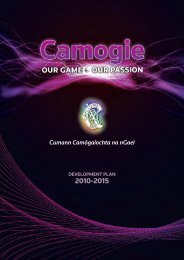Unleashing 'The Blue Wave' A Strategy for Dublin GAA - Croke Park
Unleashing 'The Blue Wave' A Strategy for Dublin GAA - Croke Park
Unleashing 'The Blue Wave' A Strategy for Dublin GAA - Croke Park
You also want an ePaper? Increase the reach of your titles
YUMPU automatically turns print PDFs into web optimized ePapers that Google loves.
UNLEASHING “THE BLUE WAVE”<br />
The Garda<br />
team, which<br />
represented<br />
<strong>Dublin</strong> in the<br />
All-Ireland of<br />
1927, is<br />
generally<br />
recognised<br />
as one of the<br />
greatest<br />
hurling sides<br />
of all time.<br />
Kickhams returned in 1919 to a much-changed <strong>Dublin</strong>, physically and<br />
politically shattered by the events of Easter Week 1916 in which as many as<br />
three hundred <strong>Dublin</strong> <strong>GAA</strong> members participated. Further away from their<br />
native city young <strong>Dublin</strong> men, again players and followers of the <strong>GAA</strong>, fell<br />
on the battlefields of the Great War. But the County Board managed to keep<br />
the games going through the War of Independence and the Civil War, albeit<br />
with championships running well beyond their calendar years.<br />
Looking back the years it seems that the summer of 1921, between the<br />
Truce and the yet to be signed Treaty, was a golden period <strong>for</strong> the <strong>GAA</strong> in<br />
<strong>Dublin</strong>. The young revolutionaries, Michael Collins, Harry Boland, Eamon de<br />
Valera, Dan Breen and Seán McKeon, often in military uni<strong>for</strong>m, were feted<br />
in <strong>Croke</strong> <strong>Park</strong>. Collins photographed, addressing the <strong>Dublin</strong> and Kilkenny<br />
hurling teams, on the role of the <strong>GAA</strong> in the revolution, prior to a Leinster<br />
hurling final is a compelling image. In other photographs from the period<br />
one can see Harry Boland, hurler and <strong>for</strong>mer chairman of the County Board,<br />
exchanging banter, as <strong>for</strong>mer players do, with his old team mates. Within a<br />
year both Collins and Boland were dead, victims of the Civil War.<br />
Three Sundays between 1918 and 1924 carry great symbolism <strong>for</strong> the <strong>GAA</strong><br />
in <strong>Dublin</strong>. In defiance of a government ban on the gathering of people to<br />
participate in Gaelic games the <strong>GAA</strong> designated Sunday, 4 August 1918 as<br />
Gaelic Sunday. ‘In one never to be <strong>for</strong>gotten tournament’, remembered<br />
Tommy Moore, ‘we crossed our hurleys with the lion’s claw and emerged<br />
victorious’. Sunday, 21 November 1920 is <strong>for</strong>ever recalled as ‘Bloody<br />
Sunday’ <strong>for</strong> the deaths of players and supporters gathered in <strong>Croke</strong> <strong>Park</strong> <strong>for</strong><br />
a football challenge match between <strong>Dublin</strong> and Tipperary. Those killed were<br />
representative of the people who played and followed the game in the city.<br />
They were the city boys from the precincts of <strong>Croke</strong> <strong>Park</strong>; the young men up<br />
from the country working in city pubs; the young girl who accompanied her<br />
fiancée to the game; and the older men from the outlying suburban clubs.<br />
Sunday, 28 September 1924, marks the beginning of modern times <strong>for</strong> the<br />
<strong>GAA</strong>. It was on that day that <strong>Dublin</strong> played and beat Kerry in the delayed<br />
1923 All-Ireland final. The Civil War had divided but not fatally damaged<br />
the Association in <strong>Dublin</strong>. Teams took the sides of their captains or other<br />
key men, but on that Sunday the game persevered and helped heal the<br />
wounds.<br />
In the later 1920s the games became one of the building blocks of the new<br />
state. Both the new police <strong>for</strong>ce, An Garda Síochána, and Army Metro<br />
recruited the best players from all over Ireland to <strong>for</strong>m teams in <strong>Dublin</strong>. The<br />
Garda hurling team won six county senior hurling championships between<br />
1925 and 1931; Army Metro won three between 1933 and 1938.<br />
Eventually under pressure from the established clubs, these almost<br />
professional outfits were disbanded, but not be<strong>for</strong>e they provided the<br />
backbone of the <strong>Dublin</strong> teams that won the county’s last hurling All-Irelands<br />
in 1927 and 1938. The Garda team, which represented <strong>Dublin</strong> in the All-<br />
Ireland of 1927, is generally recognised as one of the greatest hurling sides<br />
of all time.<br />
The most contentious issue and one that had a long-term impact on the<br />
<strong>GAA</strong> in <strong>Dublin</strong> was the Declaration Rule passed at the Annual Congress of<br />
the <strong>GAA</strong> in 1925. Under its provisions players born outside of <strong>Dublin</strong> but<br />
resident in the city could play in domestic competition in <strong>Dublin</strong> and,<br />
subject to ‘declaring’ their intentions by Easter Sunday of the calendar year,<br />
could transfer allegiance to the county of their birth <strong>for</strong> the All-Ireland<br />
championships. The rule was introduced to counter the success of<br />
institutional teams such as the Garda and Army, whom some feared were<br />
depleting rural counties of their talent to the advantage of <strong>Dublin</strong>. The<br />
Declaration Rule created a disconnection between club and county and<br />
meant that <strong>Dublin</strong> were unable to select a team from all the players<br />
participating in its championships. It is no surprise that in the period<br />
between 1925 and the 1950s, the heyday of the Rule, <strong>Dublin</strong> had a poor<br />
record in the All-Ireland championships – three football and two hurling<br />
wins between 1925 and 1973 – in contrast to the years preceding its<br />
introduction.<br />
By the year of its golden jubilee in 1934 the <strong>GAA</strong> was a settled body with a<br />
prominent place in Irish cultural life. All of the national newspapers carried<br />
14



